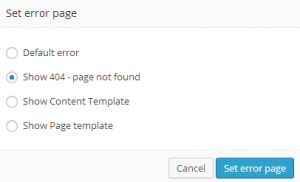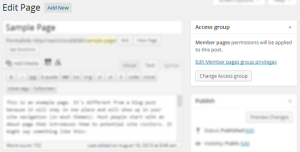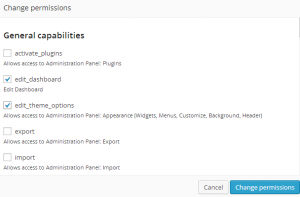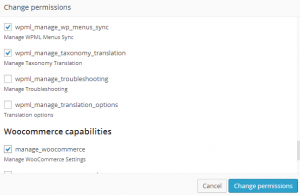Access 1.2 – Control for individual pages, no-read settings and full capabilities management
We’re very excited to announce a major new version of Access – 1.2. This new release includes big new features, many fixes and performance improvements.
Access 1.2 has grown up from a minimalistic content-type access control to full access and privileges management for WordPress.
The New Access will let you craft the exact capabilities, anywhere in the WordPress admin, for any user type. It’s fully integrated with WPML and WooCommerce, letting you enjoy easy management with accurate results.
Choose what to do when there is no read permission
Until now, when Access blocked read permission, visitors got a 404 error page. Access 1.2 lets you choose exactly what to do when visitors cannot read content.

You can choose between:
- The so friendly default 404 error page
- A page template (PHP template)
- A Views Content Template
If you want to create content sites, where non-paying visitors can see just a teaser of your content and your sign-up propaganda, you can easily implement it now, using a specialized template. Users who have read access will see the content with its ‘normal’ template. People without read access will see it with the template you’ve selected in Access admin.
Access control for individual pages
Access 1.2 lets you grant or block access to specific content in your site. Every ‘edit’ screen now includes an Access box.
You can create ‘access groups’ for pages, posts and custom type content. Then, use Access to control who can read that content in the front-end.
Manage capabilities for the WordPress admin
Access 1.2 goes beyond control for different content types. It also lets you select what different users can do in the WordPress admin.
For standard WordPress roles, or roles that other plugins create, you can view the capabilities. For roles that you create with Access, you can assign capabilities.
Full integration with WPML and WooCommerce
Access now lets you easily manage the capabilities for any plugin. It knows the capabilities of WPML and WooCommerce and lists them in simple and clear language.
This way, you can create multilingual and e-commerce sites and set up your custom roles for managing translations and the store.
WPML support requires WPML 3.1, which will be released in a few days.
Update to Access 1.2
The easiest way to get updates to Toolset plugins, including Access, is using our Installer plugin. If you are using Installer, you should see this update automatically in your admin dashboard within the next 12 hours.
You can always download updates from your Toolset account, under Downloads.
Ideas? Questions? Suggestions? Let us know by leaving a comment here.



This. Is. Awesome. It solves everything I was trying to find an answer for!
Hi Amir,
I’ll always say that Toolset has been my best invested money on the Internet (that was just my way of saying thank you for such a great work).
Now, to the point in this post: I think it would be great if you could give us an example of how it can be implemented what you say in the paragraph: “If you want to create content sites, where non-paying visitors can see just a teaser of your content and your sign-up propaganda, you can easily implement it now, using a specialized template. Users who have read access will see the content with its ‘normal’ template. People without read access will see it with the template you’ve selected in Access admin.”
Thanks again!
This page explains how to set read access to specific content:
https://toolset.com/documentation/user-guides/limiting-read-access-specific-content/
I’m working on a tutorial which explains how to create content membership sites. It will include Access (for the access control), Views for the different templates and CRED for the registration forms. I’ll do my best to have it ready this week.
Amir, this is a welcome addition to Toolset. However I was expecting to hear from the development of Views? It’s been quite a long time nothing is published about it. Something like a roadmap with status updates would be much appreciated.
Views 1.5.1 is going out either today or tomorrow. I don’t want to spoil the surprise 🙂
Thank you for the update. I’ll be refreshing the page again and again. 🙂
Here you go:
https://toolset.com/2014/02/views-1-5-1-huge-performance-boost/
Hi Amir!
I’m very interested in the “tutorial which explains how to create content membership sites” that you are creating!
I have been wanting this for a very loooong time 🙂 If this can really be done I may be able to remove one more plugin! yay!
How will we know when the tutorial is released? Will it show up here or somewhere else?
Thanks!
I’m on it. I’m trying to have it ready this week. As soon as it’s there, I’ll publish it and announce on our blog.
Excellent! Thank you for your replay, Amir … and to the whole Toolset Team – you guys rock! 🙂
Looks great!
I cannot seem to edit permissions for existing custom roles created with Access prior to v1.2.
Also, the texts in the table overlaps with the checkboes in many cases. See (http://imgur.com/1JY7YEx) and (http://imgur.com/ykhHuxo).
And there’s this new notice message at the top of the page now (possibly related to Views): “Warning: The Post Type View uses the same name for singular name and plural name. Access can’t control access to this object. Please use a different name for the singular and plural names.”
Other than this, it is a welcome improvement to Access.
You’re right about that and I forgot to mention in the blog post. The best solution would be to remove the older roles and recreate them. It’s a long story, why it’s not possible to change, but it’s really problematic, due to information that we didn’t save at the time.
1. Create new roles. Set their level and the capabilities that you need.
2. Delete the new roles. As you delete, WordPress will ask you to choose what role to migrate to. Choose the new role.
Does this work for you?
And, thanks for catching the English mistake.
I think you meant Delete the OLD roles in step 2?
Right, sorry for the typo. Delete the OLD role.
Hi,
i suggest two features :
– add collaps / Expand for each post type and taxomony section
– inverse cells tabs for each group roles because you can have more than 5 roles
– better information about custom roles, add title for each plugins
Thanks for the suggestions. They all make sense. I don’t think that WordPress keeps the information about the source of custom roles. The theme and plugins can register them, but the API doesn’t specify where they are coming from or what they do.
Maybe you can check how author of acces manager do it
http://wordpress.org/plugins/advanced-access-manager/
Hello Amir.
as we are “Views” heavy users, and since we give to the clients to access the backend as editors, we would like to have a per-page control of admin access. I’d like to protect from accidental editing by editors the template views or other “service” pages. Is it something in plans? It shouldn’t be complicated to implement.
Thank you!
For now, the best we can offer is to use the Embedded version of Views:
https://toolset.com/documentation/embedded-types-and-views/
This lets you hard-code everything, so that your end users cannot accidentally edit it.
Adding permissions to edit Views makes good sense. I’m adding this to our wishlist, but I’m not sure to what version we can add it. We already have other versions that are going to Views 1.6, so I can’t promise when.
On my localhost I have Access controlling access to the pages and posts. The intention is that only admin and a specific group do have access to a specific page which is displayed on the main menu. My user “world” who is not part of that permitted group does see it as well and I cannot disable it.
There active plugins in my WP 3.9 are only Type, Views and Access
If I disable access to pages, “world” cannot see the main menu at all thus I must allow it. As said above regretfully I cannot limit viewing of only specific pages.
Thanks for help
Are you talking about the items appearing in the navigation menu for the wrong users, or that the wrong users can actually read that content?
Detailed descriptio:
Pages and posts are managed by Access; there are no other plugins activated.
Main menu for users who are not-login should read
Home Register Login
after login role=producer – main menu should read
Home “Manage Your Medicines” Search Logout
role=”world” should see
Home Search Logout
I assigned page=”ManageYourMedicines” to access group=”drug-producer”, user “producer” is member of that group
page=”ManageYourMedicines” was added to the main menu
Fault:
after login “world” can see exactly what “producer” does
Thanks
I’m not 100% sure how this looks on your site. I’ve asked Gen, who develops Access to contact you and get the complete information.
Waiting for Gen to detail relevant questions.